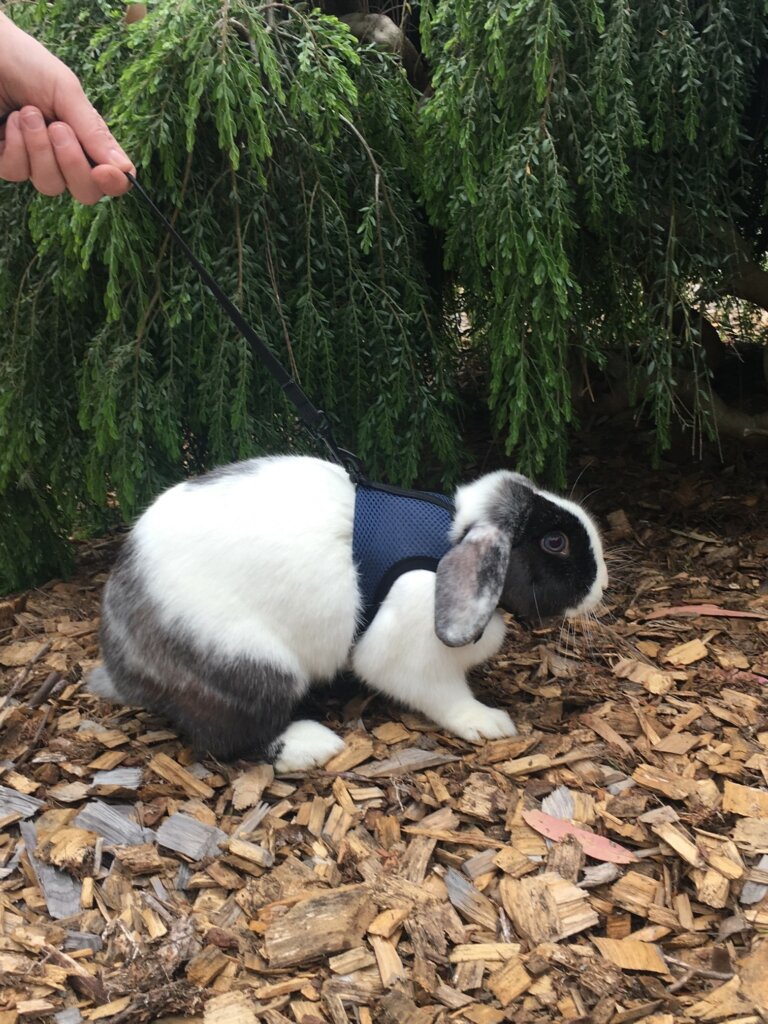Harness & litter training your rabbit
Harness training your rabbit
Rabbits are intelligent pets and enjoy exploring their environment. This exploration should be in an area that you know is safe from the dogs, cats and things that may startle your rabbit, but where exploration can be safe when a harness is utilised. Rabbits that respond well to harness training are calm and responsive, and it allows your rabbit to discover new and safe surroundings. However, rabbits take charge, unlike a dog that you would have a walk next to you.
Steps of harness training:

Step 1: Choosing a suitable harness
To begin training, you need to select a good-fitting harness and lead. Harnesses come in a few styles, either a jacket with adjustable Velcro or a H-Style harness works well. Always supervise your rabbit as they are excellent chewers and harnesses are made of fabric, meaning that only a few bites on the harness will weaken its structural integrity.
Step 2: Fitting the harness
So now that you’ve selected a harness, it is time to adjust it. Begin by adjusting it to what you expect your rabbit’s size to be BEFORE attempting to fit on your rabbit. If you needed, take the harness back off and adjust it (it is less stressful for the rabbit if you do all adjustments off the rabbit and then refit). When fitted correctly, you aim to be able to fit two fingers under the straps, with it being firm to prevent escaping but not too tight to be uncomfortable.
Step 3: Begin to Train
Training should be in 5-10 sessions. A good place to begin training is in a pen in the yard or if your rabbit is a house rabbit, an area that they are familiar with inside. Begin with fitting the harness on your rabbit, and then offer a small food reward treat. Allow your rabbit to get used to the feel of wearing the harness, although this may take a few training sessions. The next step is to attach the lead, and gently encourage your rabbit towards you by using food treats and calling its name.
Step 4: Train in a larger area
After practising with your rabbit either indoors or in an exercise pen, its time to progress to a larger area. Ensure the area is safe, free from other animals, noises that may startle the rabbit and any toxic plants or dangerous objects. If your rabbit heads towards something that you want to avoid, gain its attention by calling it and giving a gentle tug on the lead, usually this is enough encouragement for it to move towards something else. Alternatively, crouch down, call your rabbit and show it a tasty treat.
While there are some rabbits that will in fact walk alongside you whilst in a harness, most will hop along following their natural curiosity. The most important thing to remember with training is your rabbit’s safety. Some will respond well to a harness while others may find it stressful. If your rabbit is clearly uncomfortable and not responding well, consider using a pen where the rabbit can exercise and explore safely unrestrained.
Steps of litter training your rabbit:
Step 1: Choosing a suitable litter tray
Choose a litter tray that is large enough for your rabbit to comfortably fit into and low enough for it to easily jump into. Often larger rabbits will need to use a kitten or cat litter tray.
Step 2: Choosing a suitable litter
Select a litter that is not dusty or harmful to the rabbit. Recycled paper litters or hay are ideal; they are not toxic to your rabbit if it decides to nibble onto it. Avoid crystal, clumping or clay-based cat litters. Use a shallow layer of litter to avoid wastage as rabbits do not bury their droppings like cats do.
Step 3: Positioning the litter tray
Litter trays can be used either in your rabbits cage or in your house if you allow it to exercise in your home. Initially, providing the tray in a small area will be more successful, so you might want to pen a smaller area in your house. If your rabbit already has a particular area it uses to go to the toilet, it may be easier to locate the tray here and gradually move it over time to your ideal location. It is expected that your rabbit will occasionally go elsewhere, and these poos can be collected and placed in the litter tray. The scent should encourage your rabbit that is a desirable place to go.
Additionally, rabbits like to eat hay while they poo, so mounting a hay holder slightly higher than the litter tray would be ideal, as this will encourage your rabbit to sit in the litter box while they eat.
The images and text in this article have been provided by Helen Russell from Campbelltown Pets.
